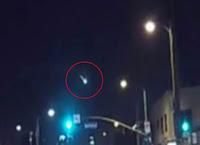Asteroid 2016 GD241 passed by the Earth at a distance of 7 643 000 km
(19.9 times the average distance between the Earth and the Moon, or 5.12% of the average distance between the Earth and the Sun), slightly before 4.30 am GMT on Moday 2 May 2016. There was no danger of
the asteroid hitting us, though had it done so it would have presented a
considerable threat. 2016 GD241 has an estimated equivalent
diameter of 99-310 m (i.e. a spherical body with the same mass would be 99-310 m in diameter), and an object of this size
would pass through the atmosphere and directly impact the ground with a
force of about 3.5-25 megatons (about 200-1500 times the
explosive energy of
the Hiroshima bomb), causing devastation over a wide area and creating a
crater 1-1.5 km across, and resulting in global climatic problems
that
could last for years or even decades.
The calculated orbit of 2016 GD241. JPL Small Body Database.
2016 GD241 was discovered on 14 April 2016 (18 days before its closest approach to the Earth) by the University of Hawaii's PANSTARRS
telescope on Mount Haleakala on Maui. The designation 2016 GD241 implies
that it was the 6029th asteroid (asteroid D241) discovered in the first
half of April 2016 (period 2016G).
2016 GD241 has a 663 day orbital period and an eccentric orbit
tilted at an angle of 11.7° to the plane of the Solar System, which
takes it from 0.34 AU from the Sun (i.e. 34% of the average distance at
which the Earth orbits the Sun, inside the orbit of the planet
Mercury) to 2.63 AU from the Sun (i.e. 263% of the
average distance at which the Earth orbits the Sun, and considerably
outside the orbit of the planet Mars). It is therefore classed as an
Apollo Group Asteroid (an asteroid that is on average further from the
Sun than the Earth, but which does get closer). This means that close
encounters between the asteroid and Earth are extremely common, with the
last having occurred in December 2012 this year and the next predicted inmay 2163. As an asteroid probably larger than 150 m in diameter
that occasionally comes within 0.05 AU of the Earth, 2016 GD241 is also
classified as a Potentially Hazardous Asteroid.
2016 GD241 also
has frequent close encounters with the planets Mercury (which it is predicted to pass next on 21 June this year) and
Venus (which it last came close to in December 1921). Asteroids
which make close passes to multiple planets are considered to be in
unstable orbits, and are often eventually knocked out of these orbits by
these encounters, either being knocked onto a new, more stable orbit,
dropped into the Sun, knocked out of the Solar System or occasionally
colliding with a planet.
See also...
 The Eta Aquarid Meteors. The
Eta Aquarid Meteor Shower will peak before dawn on Thursday 5 and Friday 6
May 2016, with up to 45 meteors per hour at it's peak, radiating from
the constellation of Aquarius. This does not spend long above the
horizon in the Northern Hemisphere at...
The Eta Aquarid Meteors. The
Eta Aquarid Meteor Shower will peak before dawn on Thursday 5 and Friday 6
May 2016, with up to 45 meteors per hour at it's peak, radiating from
the constellation of Aquarius. This does not spend long above the
horizon in the Northern Hemisphere at... Bright fireball meteor seen over Southern California. The American Meteor Society has received reports of a bright fireball meteor being seen over much of
southern California slightly at about 9.30 pm local time on Monday 23 April 2016 (about 4.30 am on Tuesday 24 April...
Bright fireball meteor seen over Southern California. The American Meteor Society has received reports of a bright fireball meteor being seen over much of
southern California slightly at about 9.30 pm local time on Monday 23 April 2016 (about 4.30 am on Tuesday 24 April...  Asteroid 2016 HO passes the Earth. Asteroid
2016 HO passed by the Earth at a distance of 808 600 km (2.10 times
the average distance between the Earth and the Moon, or 0.54% of
the average distance between the Earth and the Sun), slightly before 12.30 pm GMT on Sunday 24 April 2016. There was...
Asteroid 2016 HO passes the Earth. Asteroid
2016 HO passed by the Earth at a distance of 808 600 km (2.10 times
the average distance between the Earth and the Moon, or 0.54% of
the average distance between the Earth and the Sun), slightly before 12.30 pm GMT on Sunday 24 April 2016. There was...
Follow Sciency Thoughts on Facebook.

